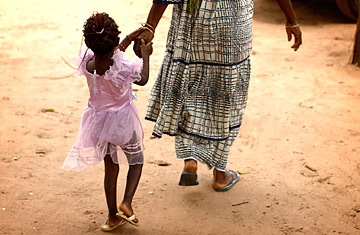
A mother and daughter walk home after a meeting about eradicating female genital mutilation in Senegal
In the age of hyperengaged parenting, globalization and the Internet, the American Academy of Pediatrics (AAP) has become a freighted organization. Every position statement released by the group — whether about breast-feeding, autism or obesity — sends waves of fury, indignation and dissent throughout the vast parenting community. In a way, this is to be expected; even a slight change in direction on the AAP's part affects millions and millions of children, who tend to inspire strong emotions in their keepers.
But the latest squall to blow back on the AAP's offices is about an issue very few American parents will ever have to deal with. On April 26, the organization changed its long-held stance on female genital cutting (FGC), a ritual that is practiced mostly in Muslim, Arabic and African counties, such as Ethiopia and Somalia — but also in certain largely Christian nations like Kenya — and is illegal in much of the West. The group now wants to explore allowing American doctors to perform a ceremonial pinprick, or small nick, on young girls if it would keep their families from pursuing circumcision. "It might be more effective if federal and state laws enabled pediatricians to reach out to families by offering a ritual nick as a possible compromise to avoid greater harm," the academy's committee on bioethics says in a policy statement.
Immigrant families that wish to preserve their local traditions sometimes approach Western doctors to perform FGC on their daughters. In its new report, the AAP advises doctors to inform families that the procedure is medically unnecessary and even dangerous. Should the families be resolute, the AAP raises the idea of legalizing a less-severe ritual cutting — akin, the policy statement says, to an "ear piercing" — to dissuade parents from sending their daughters to be circumcised in their home country, where medical conditions are likely to be far worse. "We knew that it was a controversial idea," says the report's lead author, Dena Davis, a professor at Cleveland-Marshall College of Law at Cleveland State University. "We knew simply making the language more neutral was highly controversial." (Previously, the ritual had been known as female genital mutilation, or FGM.)
The reaction was not muted. "Encouraging pediatricians to perform FGM under the notion of 'cultural sensitivity' shows a shocking lack of understanding of a girl's fundamental right to bodily integrity and equality," says Taina Bien-Aime, executive director of the human rights organization Equality Now. "If foot-binding were still being carried out, would the AAP encourage pediatricians to execute a milder version of this practice?"
The academy's compromise stance is also opposed by women from African countries, who strongly disagree with any concession "that would legitimize even the most minimal procedure," the AAP's policy statement acknowledges. The AAP concedes that it is unknown how many American families take their girls overseas for FGC and acknowledges that the policy statement was prepared without consulting communities that practice FGC about whether a ritual nick would be considered a viable alternative. However, the statement says that "in some countries where FGC is common, some progress toward eradication or amelioration has been made by substituting ritual nicks for more severe forms."
"I can't give you numbers on how many families take their daughters overseas [to be circumcised]," says Davis, "but we heard anecdotally from doctors who had fears that it had happened."
On the same day the AAP published its new recommendation, the Girls Protection Act, which would make it illegal to take a minor outside the U.S. to seek female circumcision, was introduced in Congress. "I am sure the academy had only good intentions, but what their recommendation has done is only create confusion about whether FGM is acceptable in any form, and it is the wrong step forward on how best to protect young women and girls," said one of the bill's sponsors, New York Representative Joseph Crowley, speaking to the New York Times. Davis counters that such a law would be extremely difficult to enforce.
During FGC, girls as young as 2 years old have all or part of their external genitals removed. In what is considered a rite of passage, older women remove the tip of the clitoris or perform a complete clitoridectomy. In some cases, they also remove some of the labia or sew the labia together.
The ritual is not just inconceivably ill advised and painful but also leads to all manner of health issues, immediately after the procedure and in adulthood. This is especially the case during pregnancy and childbirth, in particular if the procedure was done in unsanitary conditions. It also — and this is the point — makes sex a whole lot less enjoyable.
While some Muslim scholars say it is an acceptable practice under Islam, many others condemn it as a barbaric cultural ritual dressed in religious language. Several countries in Africa have banned FGC, but it is difficult to eradicate entirely because so many families believe that women who have not been altered will not find a good husband. The mutilation industry also offers a livelihood for the elder women in villages who provide the service and would not otherwise be able to find work.
In some instances, girls welcome the procedure as a rite of passage into womanhood; in others, girls adhere to it spurred by the belief that the clitoris will grow into a penis if left unchecked. A recent study by the Dubai Ministry of Health of more than 15,000 married Egyptian women found that only 12.4% intended to discontinue the practice.
It's not known how often FGC is performed illegally in the U.S., but one case became highly publicized in 2006: Ethiopian-born Khalid Adem, who was found to have removed his 2-year-old daughter's clitoris with a pair of scissors, became the first person in the country convicted of female genital cutting. He was sentenced to 10 years in prison.
